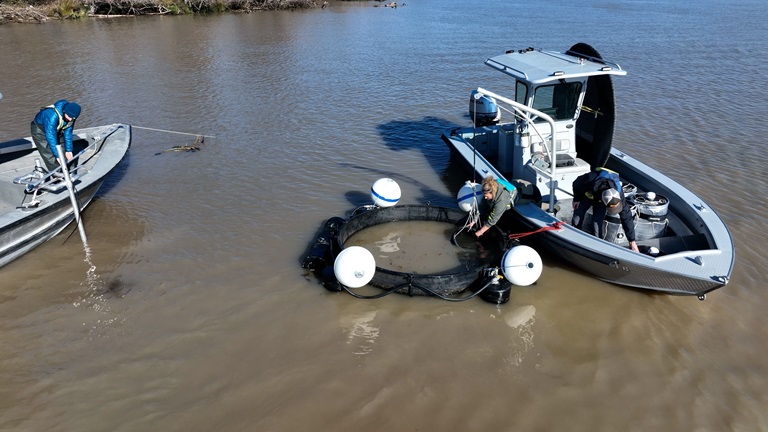DWR and Partners Experiment with Soft Release Method to Improve Delta Smelt Survival
DWR Environmental Scientist Trishelle Temple releases Delta smelt into a cage as part of an experimental soft release. The fish acclimate in the cage for 48 hours before being released into the Sacramento Deep Water Ship Channel.
Delta smelt are a fish that have gone from vast abundance to the brink of extinction. After seeing some positive results with releasing hatchery-raised Delta smelt into the wild in 2022, the Department of Water Resources (DWR) and partners are now experimenting with hard and soft release methods to see if there is a chance for even greater success and improved species survival.
DWR Senior Environmental Scientist Trishelle Tempel explains the difference between the two methods.
“In a hard release we essentially load the fish up and put them directly in the river, but in a soft release we take those same fish and put them in an enclosure and that gives them time to get used to their surroundings, maybe slow down some of their stress levels, and hopefully prepare them for better success when they get out into the water,” Tempel said.
Pulling off a soft release involved a multi-day excursion on the Sacramento River Deep Water Ship Channel that took place late-January, where DWR partnered with experts from UC Davis, the California Department of Fish and Wildlife, US Fish and Wildlife Service (USFWS), Bureau of Reclamation, and US Geological Survey (USGS).
On paper, the plan looks simple:
- Day 1 – Place cages into the water
- Day 2 – Add fish to cages and let them acclimate for 48 hours
- Day 3 – Fish continue to acclimate
- Day 4 – Release the fish into the wild
However, it takes a lot of work and preparation to pull this plan off. First, the UC Davis Fish Conservation and Culture Laboratory had to grow and raise about 50,000 Delta smelt; 6,500 of the raised fish were part of this soft release. A large team, led by USFWS, was responsible for tagging every single fish, which includes a special tag that distinguishes a hard release from a soft release.
The other key piece of the soft release experiment is the cylindrical cages the fish are placed into while they acclimate. The UC Davis Fish Conservation Physiology Lab was responsible for designing the two unique enclosures that measure about seven-feet in diameter and five-feet tall.
“It looks just like a steel sheet with holes in it, but actually the spacing makes a difference for how the hydraulics approach the cage, what the fish actually experience within the cage,” said Dennis Cocherell, Physiology Lab manager. The cage design also reduces water speed as the river flow increases, while allowing enough water to replenish food and oxygen and deplete ammonia that builds up.
While the fish spend 48-hours hanging out, Cocherell said that time is essential. “From boat noise to predators, they can experience the environment safely as a group, so when they are released, they can hopefully stay together as a school,” Cocherell said.
After 48-hours of acclimation, the tops of the cage are detached and the air is removed from the side tanks, which sinks the cage down so the fish can come out together and swim away as a school.
Thanks to this project’s partnership with USGS and its sonar imaging system, the team is confident they are giving the fish the best chance possible for survival.
“We know they are leaving as a group of fish, and that’s exactly what we wanted,” Cocherell said.
Tempel said a marker of success is if some of the tagged soft release Delta smelt are found in long-term monitoring programs.
“We can find out how they did, and where they went, and how long they lived,” she said.
While the UC Davis Fish Conservation and Culture Laboratory has already started spawning the next batch to be released this following winter, the team is staying optimistic.
“There’s this ongoing thought of Delta smelt as a wimpy fish, but I think they’re actually more resilient than people give them credit for," Tempel said.
Now, the hope is that these tagged Delta smelt will be caught later in the year by other researchers in the Delta. This would help the team tailor future release methods to improve the chance of survival for Delta smelt.
“It’s exciting to see our babies go out into the environment and be caught later on, since that means the environment is still good for Delta smelt,” Cocherell said. “We still have opportunity to save a species.”
